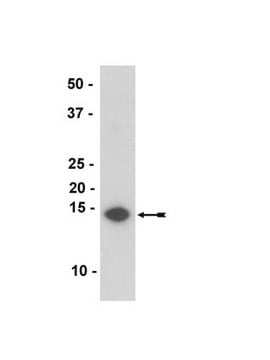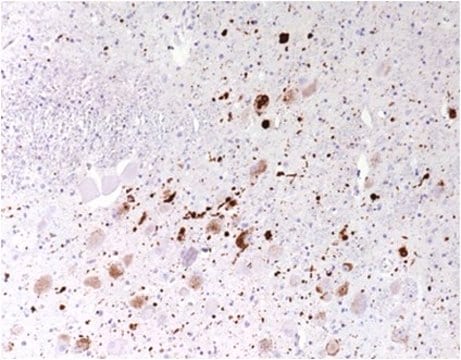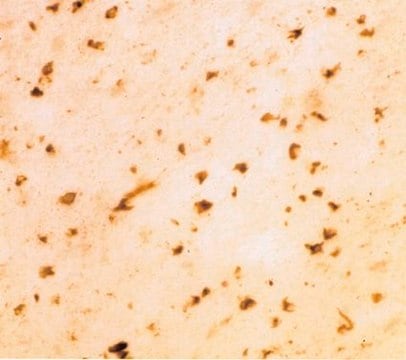MABN1817
Anti-α-Synuclein Antibody, clone 2F12
clone 2F12, from mouse
Sinónimos:
Alpha-synuclein, NACP, Non-A beta component of AD amyloid, Non-A4 component of amyloid precursor, Synuclein alpha-140
About This Item
Productos recomendados
origen biológico
mouse
Nivel de calidad
forma del anticuerpo
purified immunoglobulin
tipo de anticuerpo
primary antibodies
clon
2F12, monoclonal
reactividad de especies
rat, human, mouse
técnicas
ELISA: suitable
immunocytochemistry: suitable
immunohistochemistry: suitable (paraffin)
immunoprecipitation (IP): suitable
western blot: suitable
isotipo
IgG2bκ
Nº de acceso NCBI
Nº de acceso UniProt
Condiciones de envío
ambient
modificación del objetivo postraduccional
unmodified
Información sobre el gen
human ... SNCA(6622)
Descripción general
Especificidad
Inmunógeno
Aplicación
ELISA Analysis: A representative lot (0.4 µL in 30 µL buffer/well for coating) captured recombinant human α-synuclein (0.2-40 ng/mL) in a sandwich ELISA application utilizing clone SOY1 (Cat. No. MABN1818; preconjugated with Sulfo tag) as the detection antibody (Courtesy of Tim Bartels, Ph.D., Brigham and Women′s Hospital, Boston, MA, U.S.A.).
Immunocytochemistry Analysis: A 1:1,000 dilution from a representative lot immunostained primary mouse cortical neurons (Courtesy of Tim Bartels, Ph.D., Brigham and Women′s Hospital, Boston, MA, U.S.A.).
Immunohistochemistry Analysis: A 1:11,110 dilution from a representative lot immunostained Lewy bodies (LBs) in striatum tissue sections from Parkinson′s diseased (PD) human brain (Courtesy of Tim Bartels, Ph.D., Brigham and Women′s Hospital, Boston, MA, U.S.A.).
Immunoprecipitation Analysis: 4 µL from a representative lot immunoprecipitated α-synuclein from 50 µg of HEL human erythroleukemia cell lysate (Courtesy of Tim Bartels, Ph.D., Brigham and Women′s Hospital, Boston, MA, U.S.A.).
ELISA Analysis: A representative lot captured both endogenous α-synuclein (αS) from human cortical homogenate, as well the exogenously expressed wild type and familial PD (fPD) αS mutants (A30P, E46K, H50Q, G51D, A53T) from sytosolic extracts of transfected M17D human neuroblastoma cells in a sandwich ELISA application utilizing clone SOY1 (Cat. No. MABN1818; preconjugated with Sulfo tag) as the detection antibody (Dettmer, U., et al. (2015). Nat. Commun. 6:7314).
ELISA Analysis: A representative lot captured both pre-aggregated fibrillar recombinant α-synuclein as well as partially purified Lewy bodies (LBs) from a DLB (dementia with LBs) patient with or without prior sample denaturing by boiling with 2% SDS in a sandwich ELISA application utilizing clone SOY1 (Cat. No. MABN1818; preconjugated with Sulfo tag) as the detection antibody (Dettmer, U., et al. (2015). Nat. Commun. 6:7314).
Immunocytochemistry Analysis: A representative lot detected cytosolic localization of endogenous rat α-synuclein (αS) and exogenously overexpressed human αS by fluorescent immunocytochemistry staining of 4% paraformaldehyde-fixed, 0.25% Triton X-100-permeabilized primary rat neurons and transfected M17D human neuroblastoma cells (Dettmer, U., et al. (2015). Nat. Commun. 6:7314).
Western Blotting Analysis: A representative lot detected monomeric α-synuclein (αS) as well as αS multimers (αS60, αS80 and αS100) in extract from disuccinimidyl glutarate (DSG) cross-linked mouse brain bits, human iPSCs (both S A53T mutant and corrected isogenic line) and ESCs (both wild-type and genetically engineered isogenic αS E46K line). A significantly reduced αS60 level was seen with A53T and E46K mutants (Dettmer, U., et al. (2015). Nat. Commun. 6:7314).
Western Blotting Analysis: A representative lot detected monomeric α-synuclein (αS) as well as αS multimers (αS60, αS80 and αS100) in cytosolic extracts from disuccinimidyl glutarate (DSG) cross-linked primary rat neurons, as well as human HEL erythroid leukemia and M17D neuroblastoma cells (Dettmer, U., et al. (2013). J. Biol. Chem. 288(9):6371-6385).
Neuroscience
Calidad
Western Blotting Analysis: A 1:1,000 dilution of this antibody detected α-synuclein in 10 µg of human fetal brain tissue lysate.
Descripción de destino
Forma física
Almacenamiento y estabilidad
Otras notas
Cláusula de descargo de responsabilidad
Not finding the right product?
Try our Herramienta de selección de productos.
Opcional
Código de clase de almacenamiento
12 - Non Combustible Liquids
Clase de riesgo para el agua (WGK)
WGK 1
Punto de inflamabilidad (°F)
Not applicable
Punto de inflamabilidad (°C)
Not applicable
Certificados de análisis (COA)
Busque Certificados de análisis (COA) introduciendo el número de lote del producto. Los números de lote se encuentran en la etiqueta del producto después de las palabras «Lot» o «Batch»
¿Ya tiene este producto?
Encuentre la documentación para los productos que ha comprado recientemente en la Biblioteca de documentos.
Nuestro equipo de científicos tiene experiencia en todas las áreas de investigación: Ciencias de la vida, Ciencia de los materiales, Síntesis química, Cromatografía, Analítica y muchas otras.
Póngase en contacto con el Servicio técnico








